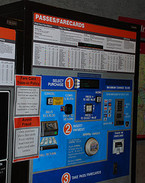Can Metrorail fares be simpler?

Photo by afagen on Flickr.
During a review of fare policies, WMATA recently conducted focus groups in which customers said they wanted fares to be simpler. They said they especially didn’t like confusing three-column fare table available in Metrorail stations. Here’s one way the Metrorail fare structure could be simplified.
First, a refresher on how Metrorail fares work “under the hood.” There are two basic schedules for rail fares, regular and reduced, which most people think of as “peak” and “off-peak.” All the fares are based on “composite miles,” which is the average of the distance you travel along the rails and the distance between the stations “as the crow flies.”
For SmarTrip users, Metro charges between $1.60 and $2.75 for reduced fares and $1.95 to $5.00 for regular fares, depending on distance. When you ride using a paper farecard, Metro adds $0.25 to the SmarTrip fare.
When you ride during the hours of 7-9:30 am or from 4:30-6 pm on weekdays, Metro adds $0.20 for “peak of the peak” fare. This requires Metro to have a three-column table showing each possible destination station and the cash regular, reduced and peak-of-the-peak fares.
If we could get rid of the need for three different time periods for cash users, that would make buying farecards a lot simpler.Metro could simplify the fare system with a plan like this:
Make paper farecards always regular (peak) fare, rounded up to the nearest quarter. Paper farecard customers during off-peak represent a very small portion of the ridership. I assumed that 75% of the ridership was peak, and that 75% of the riders use SmarTrip, so less than 10% of the riders are farecard off-peak. People that want to enjoy discounted fares should obtain a SmarTrip card. London uses this system, charging cash customers £4 cash for a one-zone downtown ride, with discounted fares available if you use an Oyster card.
Abolish the peak-of-the-peak fare. It’s too complicated. Even though I recommended it, it seems that people hate it even more than I imagined, and it leaves Metro open to criticism that people are paying more for service that isn’t much better. Before anyone gets too happy about peak-of-the-peak being gone, very few people get a net discount under my plan compared to the current fares, due changes in the distance-based pricing.
Set reduced (off-peak, SmarTrip) fares at half of the equivalent regular fare, but at least the same as the SmarTrip bus fare. Under this part of the plan, SmarTrip reduced fares generally become cheaper than under the existing Metro fares. Together with the previous two changes, this cuts the three-column fare table down to one column, since the reduced fare no longer exists (for farecards) or is just half the regular fare (for SmarTrips). So if, for example, the SmarTrip bus fare is $1.50, the Smartrip fares would be between $1.50 and $2.60.
Regular fares get a new schedule. The regular fares increase to $2.00 to $5.25 based on distance. Under this change, the biggest SmarTrip change is for a middle-distance regular fare, and most short distance peak-of-the-peak riders see a discount. Most long distance fares increase 5%, which affects about 7% of riders.
This proposal collects about the same amount of revenue as the existing fare structure. The net revenue effect of all these changes under static analysis (assuming no rider behavior changes) is about a 1.4% revenue increase.
If this proposal were adopted, customers buying Metrorail farecards would see a much simpler fare table on the vending machines. It would have only one price for each Metrorail destination, so they wouldn’t have to figure out the difference between peak, peak-of-the-peak and off-peak pricing. SmarTrip customers would have only the peak and off-peak fares to worry about, and the off-peak pricing would be a little more predictable since it’s half of the regular fare. This is a lot simpler, while preserving distance-based pricing and the opportunity to save money during off-peak, which are key features of the WMATA fare system.
